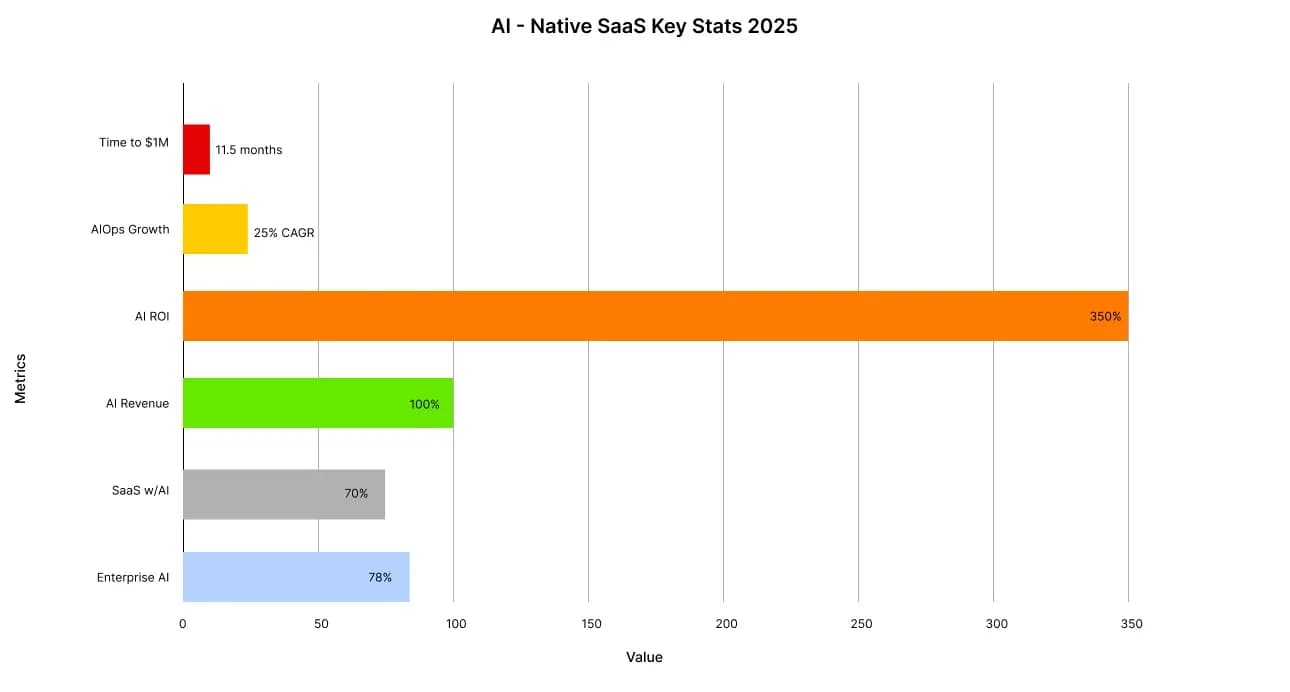Back
Updated at: October 17, 2025
The AI-Native SaaS Revolution: How AIOps Transformed Corporate Operations in 2025

The corporate software landscape changed dramatically in 2025. All the optimistic forecasts have come true, and AI is no longer just an improvement, but the foundation of the next generation of software platforms.
The objective figures are such that AI-native SaaS companies showed a 4x greater average annual revenue growth compared to traditional companies – 100% growth versus 23%.
And the reason for this is not simply the scale of AI function integration, but the continuous learning from user experience and assigning AI a core role in competence.

Key Stats: AI-Native SaaS Market Performance in 2025
The Scale of AI-Native Transformation
Enterprise Adoption: Critical Mass Has Been Reached
Around 78% of companies globally use AI in at least one business function at the moment, a significant increase from 55% two years ago. This suggests that AI has already achieved the critical mass needed for a broad industry transformation and will move from experimentation to necessity in 2025.
In North America and Europe, where companies are implementing the most aggressive AI integration strategies, these shifts are especially apparent.
70% of SaaS companies have already integrated AI into their products, and the vast majority have moved from chatbots to modern machine learning (ML) systems that are constantly adapting to user requests.
Top ML implementation use cases are centered around so-called "learning loops", where AI systems automatically improve based on customer usage patterns, generating what industry analysts call "speed to value" – the cumulative improvement in value delivery over time.
AIOps Growth: An Explosion in the Market
The AIOps (Artificial Intelligence for IT Operations) market experienced explosive growth, increasing from $8.91 billion in 2024 to $11.6 billion in 2025 – a year-over-year growth of 25.3%. Several research firms predict that the market will reach between $32.56 billion and $40.19 billion by 2030–2033, representing a compound annual growth rate (CAGR) of between 17.8% and 30.7%. This growth is driven by the urgent need for businesses to manage increasingly complex IT environments while simultaneously reducing operational costs.
North America, as usual, dominates the AIOps market, holding over 40% of its share, driven by the rapid adoption of AI-based automation technologies and high demand for efficient IT operations management across all industries.
The region's leadership reflects both the advantages of its technological infrastructure and its cultural readiness to embrace operational changes driven by AI.
The Speed of Profit Accumulation as a New Form of Competition
AI Startups: New Timelines
AI-first companies are consistently beating traditional SaaS growth metrics.
AI startups reach an annual revenue of $1 million in just 11.5 months, compared to 15 months for traditional SaaS companies, and they achieve an annual revenue of $5 million in 24 months, compared to 37 months for regular software development companies.
This 4-month advantage at the $1 million mark and a 13-month advantage at the $5 million mark reflect a fundamental operational efficiency that accumulates over time.
The most striking examples include companies like Cursor, which achieved $100 million in revenue in just 12 months with only 30 employees – an accomplishment that traditionally required teams of 500+ people.
Similarly, Lovable achieved an annual revenue of $70 million in just 7 months.
And DeepSeek reportedly reached an annual revenue of $200 million in less than a year.
These examples are not exceptions to the rule, but rather representations of a new operational paradigm in which AI delivers unprecedented levels of efficiency.
The Operational Efficiency Revolution
Traditional SaaS companies typically generate between $0.2 and $0.4 million in annual recurring revenue (ARR) per employee, while AI-native companies operate at a rate of $0.5 to $1 million in ARR per employee, effectively doubling traditional productivity metrics.
This efficiency advantage is due to AI’s ability to automate complex workflows, improve decision-making processes, and scale operations without a proportional increase in staff.
AI-first companies with annual recurring revenue under $1 million in 2024 saw a 93% revenue increase, significantly outpacing traditional software companies.
Accelerated growth reflects AI’s ability to create self-improving systems that deliver increasing value without requiring a linear expansion of resources.
Profit and Metrics: The Quantitative Value of AI
Excess Expected Profit
Companies that use AI successfully report ROI of $3.50 for every dollar they invest.
About 74% of them say their AI projects meet or exceed their investment return goals.
At least 20% of businesses say they get more than 30% ROI, particularly on automation, predictive analytics, and improving customer experience.
The healthcare sector shows a very high return on AI investment: for every dollar spent, there is a $3.20 profit.
This shows that changing how patients are cared for and how hospitals run is good for both public health and the economy.
At the same time, 65% of businesses that use generative AI say they get $3.70 back for every dollar they spend, especially on content creation, software development, and design.
Metrics of Operational Impact
Real-world implementation examples demonstrate specific operational improvements across several areas:
- H&M’s virtual assistant independently resolved 70% of customer inquiries, leading to a 25% increase in conversion rate during chatbot interactions and a threefold acceleration in response time.
As a result, revenue per visitor increased and customer support expenses were significantly reduced. - IBM’s AIOps deployment has enabled it to manage a massive volume of IT alerts by intelligently filtering signals from noise, correlating related events, and recommending corrective actions in real time.
The implementation significantly reduced false positives and accelerated incident resolution time.
Increased labor productivity in companies demonstrates consistent patterns:
Generative AI increases the productivity of junior staff by 20–30%, and the efficiency of senior staff by 10–15%.
These improvements are accumulating across all departments, creating organization-wide efficiency gains that justify further investment in AI.
How-to: Pilot to Production Implementation
Basis for Integration AI
Leading enterprises are taking a methodical approach to AI-driven change, beginning with a strategic alignment of AI projects with their main business objectives.
In order to find the best use cases where AI can yield immediate benefits, successful implementations start with cross-functional brainstorming sessions involving stakeholders from marketing, operations, HR, and customer service departments.
Companies should focus on "quick wins" that have quantifiable business impact while also developing the capacity for long-term change.
The most successful strategy begins with pilot projects that show a definite ROI in three to six months, and then uses well-established MLOps practices to scale successful implementations throughout the company.
Scaling AI in Enterprise Operations
Companies allocating more than 5% of their IT budget to AI achieve a positive ROI of 70–75%, while those spending less than 5% only reach a 50–55% return.
This correlation demonstrates that significant AI transformation requires substantial and sustained investment, rather than being limited to minor experiments.
The best AI-using companies allocate 56% of their R&D spending to AI development, compared to just 28% for traditional users.
The cumulative effect of consistent investment in AI produces increasingly hard-to-replicate competitive advantages, which explains why AI-first companies achieve 132% net dollar retention compared to 108% for traditional SaaS.
Models in the Regions
US Leadership: With 8.7% of businesses actively utilizing AI as of spring 2025, American companies are spearheading the aggressive adoption of AI.
However, this represents a notable concentration among larger, more technologically sophisticated organizations.
And the relatively low percentage indicates enormous potential for growth, especially among mid-sized companies.
Measured AI Adoption in Europe: In 2024, the level of AI adoption in European companies reached 13.5%, compared to 8.0% in 2023.
Large EU enterprises show an adoption rate of 41%, indicating that organizational size and resources significantly impact the success of AI implementation.
The European approach emphasizes responsible AI practices and adherence to regulatory requirements, which potentially creates long-term sustainability benefits.
Acceleration in the UK: British companies have moved from 9% AI adoption in 2023 to an expected 22% in 2024, with 14% planning to implement it within three months as of June 2025.
This rapid acceleration reflects competitive pressure and the recognition that AI adoption is becoming necessary for market competitiveness and survival.
Transformation History by Industry
Financial Services: Risk and Efficiency
JPMorgan Chase reduced fraud losses by 20% while improving the accuracy of reporting to regulators thanks to AI-powered fraud detection and compliance systems.
The bank's implementation experience demonstrates AI’s ability to simultaneously enhance both security and operational efficiency under strict regulation.
Morgan Stanley boosted advisor productivity and accelerated client acquisition with AI-powered wealth management tools.
These systems allow financial advisors to provide more personalized recommendations while efficiently managing large client portfolios.
Medicine and Pharmacy
Pfizer has reduced the time to develop new drugs by 18%, while simultaneously increasing the efficiency of clinical trials through the use of AI for drug discovery and research acceleration.
This reduction in timelines has profound implications for bringing life-saving treatments to market faster, while simultaneously lowering development costs.
UnitedHealth Group has automated 50% of claims processing while simultaneously improving diagnostic accuracy in medical imaging.
This automation reduces administrative costs, allowing healthcare providers to focus on patient care rather than paperwork.
Retail Trade
Walmart reduced out-of-stock items by 30% by optimizing logistics for faster delivery using AI in supply chain and inventory management.
The implementation demonstrates AI’s ability to simultaneously improve customer service quality and operational efficiency.
Procter & Gamble improved demand forecasting accuracy by 40%, while simultaneously increasing the return on marketing investment thanks to AI-powered predictive analytics.
More accurate forecasting reduces waste while allowing for more targeted marketing investments.
AI Ops: Redefining Operational Excellence
Intelligent IT Operations at Scale
AIOps platforms combine artificial intelligence with IT operations to automate routine tasks, detect anomalies, and make real-time decisions.
Businesses using AIOps report a 42% decrease in operating expenses through automation and enhanced productivity, and a 59% increase in revenue as a result of better customer relations and optimized decision-making.
By eliminating false positives and low-priority alerts, AIOps helps teams concentrate on important incidents while reducing information noise and alert fatigue.
Automated incident remediation fixes recurring problems on its own, while accelerated root cause analysis correlates data from networks, applications, and infrastructure to detect outages more quickly than manual troubleshooting.
Proactive Operations Management
The most advanced AIOps implementations go beyond reactive problem-solving, moving toward predictive maintenance and proactive optimization.
Machine learning algorithms detect patterns that precede system failures, allowing IT teams to resolve issues before they impact users.
This shift from reactive to proactive operations represents a fundamental change in IT service delivery.
AIOps-using organizations report a 30–50% decrease in Mean Time to Recovery (MTTR) as a result of automated remediation and root cause analysis.
Although a 50% reduction in escalations to engineers frees up technical teams to concentrate on strategic projects rather than fighting fires, a 40% reduction in unplanned downtime enhances Service Level Agreement (SLA) compliance and overall system availability.
Experts: This is the Way Forward
Market Evolution and Competitive Dynamics
Industry analysts predict that by 2027, architectures originally designed for AI will become the dominant SaaS model, and traditional software companies will face increasing pressure to rebuild rather than retrofit their platforms.
Businesses that see AI as just a function rather than a core competency run the risk of always being at a competitive disadvantage, as competitors who are AI-native fortify their market positions through ongoing learning and development.
The time for AI-powered change is quickly coming to an end. Businesses that delay full AI integration run the risk of losing ground to rivals permanently. Furthermore, the platform needs to be fundamentally restructured rather than improved gradually.
Harnessing Technology Together
The use of Edge AI is growing faster; at the moment, 52% of AI models have fewer than one billion parameters.
This shift to more compact, efficient models lowers computational costs by up to 40% while enabling real-time processing at the edge.
By 2030, the edge AI market is projected to grow to $66.47 billion, making distributed intelligence a crucial differentiator.
Multi-cloud and hybrid infrastructure strategies are becoming essential for AI-driven operations as well.
Organizations need flexible, scalable platforms that can adapt to changing computing demands while maintaining security and compliance standards in distributed environments.
Resources and Investing
Budgets for corporate AI are expanding quickly: 88% of businesses currently spend more than 5% of their IT budget on AI, and many more intend to do so soon – by as much as 25%.
The fact that more than half of company executives intend to double their AI budgets in the upcoming year suggests that investing in AI is evolving from an experimental cost to a strategic necessity.
Instead of incremental experimentation, sustained and substantial investment is necessary for a successful AI-powered transformation.
Businesses that treat AI as a collection of discrete fixes constantly fall behind those that are dedicated to platform transformation and extensive reorganization.
Strategic Suggestions: Establishing an AI-Powered Benefit
Urgent Measures
- Evaluate the current level of AI maturity by carrying out thorough audits of the data infrastructure, organizational preparedness, and AI capabilities.
Before creating successful transformation roadmaps, organizations must understand where they are at the moment. - Find use cases where AI can provide quantifiable business benefit in less than 90 days by starting with high-impact pilot initiatives.
To create momentum for more significant changes, concentrate on applications with measurable ROI and minimal organizational resistance. - Invest in infrastructure that is AI-focused:
Complex AI systems require data storage and processing power that traditional IT architectures cannot provide.
It must be scalable, cloud-based solutions made for workloads involving machine learning.
Long-Term Plan
Dedication to Sustainable Investing: Companies ought to make a commitment to multi-year investment plans that will enable a comprehensive platform modernization.
When it comes to implementing AI, superficial feature additions and other half-measures always fall short.
The future of enterprise software belongs to those companies that act early.
If your business is ready to move from experiments with AI to building intelligent, learning-driven platforms - let’s make it happen together.
We Can Develop IT - your partner in creating a real AI-powered transformation.
Summary:
The corporate software landscape has undergone significant changes as AI has become a foundational element of modern software platforms. AI-native SaaS companies are experiencing much higher revenue growth compared to traditional firms, reflecting the transformative impact of AI integration. A considerable majority of businesses now utilize AI in at least one operational function, highlighting a shift from experimentation to necessity. The AIOps market, which focuses on applying AI to IT operations, has also seen substantial growth, driven by the need for efficient management of complex IT environments. AI-first companies have demonstrated remarkable operational efficiency, achieving revenue milestones more quickly than their traditional counterparts. Companies that effectively implement AI report high returns on investment, with many seeing substantial profits from their AI initiatives. Various industries, including healthcare and finance, are harnessing AI to enhance productivity, reduce costs, and improve service delivery. Enterprises are encouraged to adopt a strategic approach to AI implementation, prioritizing pilot projects that yield measurable benefits. As AI integration becomes more critical, businesses are advised to allocate significant portions of their budgets to AI initiatives to achieve long-term success. Overall, the evolution of AI in corporate operations signals a shift toward more intelligent, efficient, and competitive business practices.
Read also:
AInativeSaaS
AIOps
AIinbusiness
AIrevolution
corporatetransformation
futureofSaaS
AIautomation
AIoperations
AIefficiency
AI2025
artificialintelligence
AIgrowth
AIinnovation
AIstrategy
AIenterprise
AIROI
AIintegration
AIsoftware
AIstartups
AIproductivity
AItransformation
AItechnology
AI-drivencompanies
AIcloud
AItrends
AIbusiness
AIinsights
AIperformance
AIanalytics
AIopsmarket
AIscalability
AIefficiencyrevolution
AIinnovation2025




